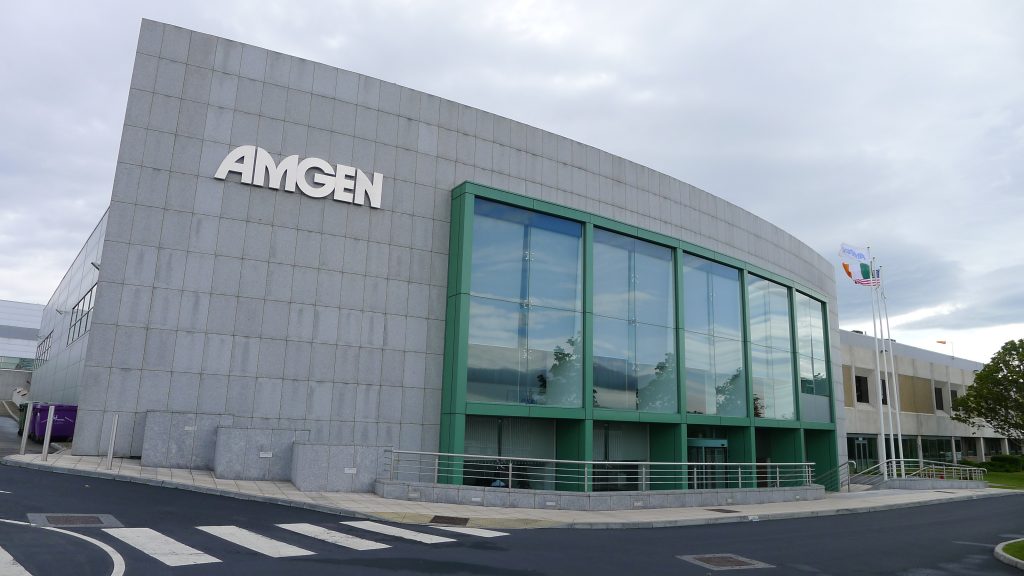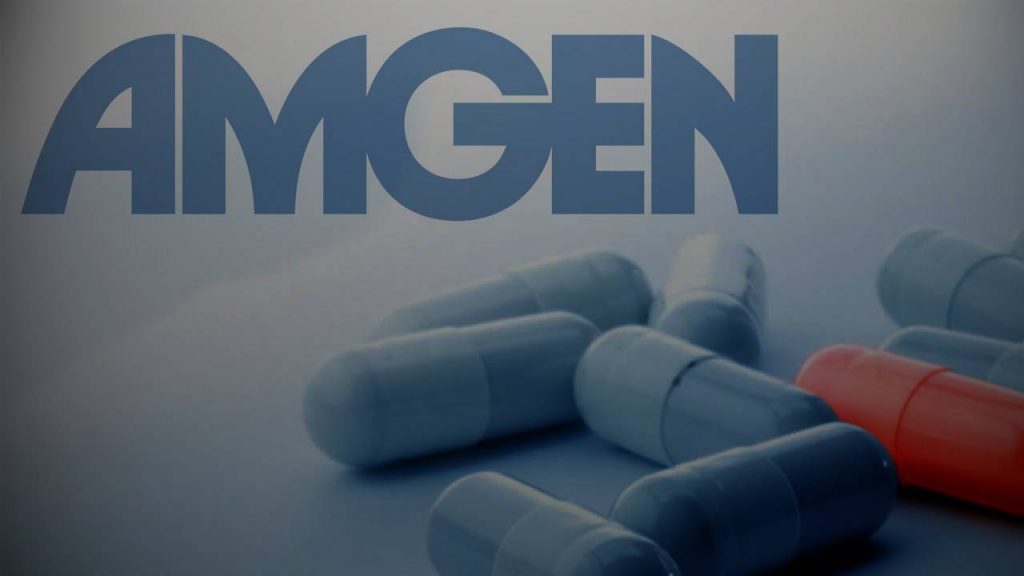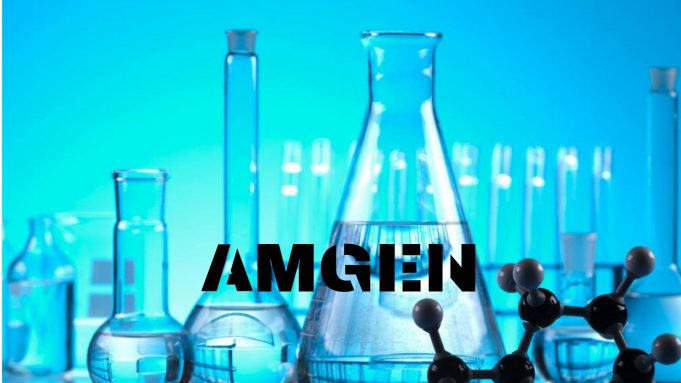This report provides the last five years revenues and revenue growth of Amgen Inc (AMGN) from 2012 to 2016. Amgen generated a total of $23 billion revenues during 2016. Amgen reported a revenue growth of 6.1% year-over-year during 2016. The revenues and the revenue growth correspond to the fiscal year ending in December.
AMGEN REVENUES FROM 2012 TO 2016
Here are the revenues and the revenue growth details of Amgen during the last five years:
- Amgen generated a total of $17.3 billion revenues during 2012. Amgen reported a revenue growth of 10.8% year-over-year during 2012.
- Amgen generated a total of $18.7 billion revenues during 2013. Amgen reported a revenue growth of 8.2% year-over-year during 2013.
- Amgen generated a total of $20.1 billion revenues during 2014. Amgen reported a revenue growth of 7.4% year-over-year during 2014.
- Amgen generated a total of $21.7 billion revenues during 2015. Amgen reported a revenue growth of 8% year-over-year during 2015.
- Amgen generated a total of $23 billion revenues during 2016. Amgen reported a revenue growth of 6.1% year-over-year during 2016.

WHY ANALYZE REVENUE GROWTH?
Revenue growth is the most commonly analyzed financial metric. Revenue Growth is the percent increase (or decrease) of a company’s revenue between two time periods. It is computed by using the following formula: ((revenues during the time period two – revenues during the time period one) / revenues during the time period one)*100. If the time periods are two consecutive years, then the revenue growth is referred to as the annual revenue growth year-over-year. If the time periods are two consecutive quarters, then the revenue growth is referred to as the quarterly revenue growth quarter-over-quarter. If the time periods refer to the same quarter in the two consecutive years, then the revenue growth is referred to as quarterly revenue growth year-over-year. In case the time periods are two non-consecutive years, then the revenue CAGR (Commutative Annual Growth Rate) is computed.
Revenue growth analysis is important for a number of reasons. First, it helps in understanding how a business is performing. If the revenue growth rates are positive, it means the business is performing well and the revenues are increasing. If the revenue growth rates are negative, it means the revenues are declining and the company needs to take measures to increase them. If they don’t, the company will continue to shrink. Second, a company’s historical revenue growth analysis along with the market size and market share analysis helps in forecasting the future revenues of a company. Third, a comparison of a company’s growth rates with its competitors helps in determining who is winning more business. A revenue growth higher than the industry average translates into increasing market share. Companies with very high revenue growth rates have the potential to be the industry disrupters.

AMGEN RANKING
With $23 billion revenues, Amgen ranked number 119 in the R&P; Research list of top-3000 public companies in the US by revenues during 2016. Each one of the top-3000 companies generated more than $50 million of annual revenues during 2016.
The top-20 companies in the US by revenues during 2016 were:
- Walmart ($482.1 billion)
- ExxonMobil ($226.1 billion)
- Berkshire Hathaway ($223.6 billion)
- Apple ($215.6 billion)
- McKesson ($190.9 billion)
- UnitedHealth Group ($184.8 billion)
- CVS Health ($177.5 billion)
- General Motors ($166.4 billion)
- AT&T; ($163.8 billion)
- Ford Motor ($151.8 billion)
- AmerisourceBergen ($146.8 billion)
- Amazon ($136 billion)
- Verizon ($126 billion)
- General Electric ($123.7 billion)
- Cardinal Health ($121.5 billion)
- Costco ($118.7 billion)
- Walgreens Boots Alliance ($117.4 billion)
- Chevron ($114.5 billion)
- Kroger ($109.8 billion)
- Express Scripts Holding ($100.3 billion)
For the purpose of performance benchmarking of a company with a sector or industry average, R&P; Research associates every company with one sector and one industry. An industry consists of companies with related/similar business models. A sector comprises of a group of related/similar industries. For high-level analysis purposes, related/similar sectors are grouped into sector groups.

For example, Healthcare sector group is comprised of Life Sciences sector and Healthcare Services sector. Life Sciences sector is comprised of following industries: Pharmaceuticals; Medical Devices; Biotechnology; Diagnostics & Scientific Instruments. Healthcare Services sector is comprised of following industries: Medication Stores, PBM and Distributors; Healthcare Payers; Healthcare Providers; Medical Software; Healthcare Research Services.
Amgen is associated with Healthcare Sector Group, Life Sciences Sector and Biotechnology Industry.
With $23 billion revenues, Amgen ranked number 21 of all the companies in the US Healthcare sector group. There were a total of 290 public companies in the US Healthcare sector group that had revenues greater than $50 million during 2016.

The top-10 companies in the US Healthcare sector group by revenues during 2016 were:
- McKesson ($190.9 billion)
- UnitedHealth Group ($184.8 billion)
- CVS Health ($177.5 billion)
- AmerisourceBergen ($146.8 billion)
- Cardinal Health ($121.5 billion)
- Walgreens Boots Alliance ($117.4 billion)
- Express Scripts Holding ($100.3 billion)
- Anthem ($84.9 billion)
- J&J; ($71.9 billion)
- Aetna ($63.2 billion)
Healthcare sector group is comprised of the following sectors: Life Sciences; Healthcare Services.
With $23 billion revenues, Amgen ranked number 7 of all the companies in the US Life Sciences sector. There were a total of 197 public companies in the US Life Sciences sector that had revenues greater than $50 million during 2016.
The top-10 companies in the US Life Sciences sector by revenues during 2016 were:
- J&J; ($71.9 billion)
- Pfizer ($52.8 billion)
- Merck ($39.8 billion)
- Gilead Sciences ($30.4 billion)
- Medtronic ($28.8 billion)
- Abbvie ($25.6 billion)
- Amgen ($23 billion)
- Eli Lilly ($21.2 billion)
- Abbott Laboratories ($20.9 billion)
- Bristol Myers Squibb ($19.4 billion)
Life Sciences sector is comprised of the following industries: Pharmaceuticals; Medical Devices; Biotechnology; Diagnostics & Scientific Instruments. The definitions for each of the industries is as follows:
- Pharmaceuticals industry includes companies that discover, develop, manufacture, and market medicines licensed for use as medications. In general these companies offer pharmaceutical products that can be described as prescription or over-the-counter medicines. Many Pharmaceutical companies also offer a diverse portfolio of animal health products, services and solutions. Many diversified pharmaceutical companies operate in more than two operating segments like consumer health products, medical devices and pharmaceutical.
- Medical Devices industry includes manufacturers and distributors of medical equipments and medical supplies. Medical equipments include large scale capital equipmets such as X-Ray machines and MRI scanners and other nondisposable medical devices like stents and pacemakers. Medical supplies include makers of contact lenses, eyeglass lenses, bandages and other disposable products.
- Biotechnology industry includes Biotechnology product companies, subscription companies, and service companies. Biotechnology product companies offer pharmaceutical medication products that are manufactured in, extracted from, or semi synthesized from biological sources. Subscription-based companies develop genome databases, which can be used to develop medicinal medications. Service companies offer solutions based on a common technology or generic tool of other large pharmaceutical or biopharmaceutical companies.
- Diagnostics & Scientific Instruments industry includes companies that provide testing products, diagnostic reagents, instruments and diagnostic services to aid in the detection and treatment of a wide range of diseases. It also includes molecular diagnostic and genetic testing companies that develop, manufacture, market and provide diagnostic tests, diagnostic systems and related products and services. Also included are companies that manufacture and market analytical instruments, equipment, reagents and consumables, software and services for research, manufacturing, analysis, discovery and diagnostics.

With $23 billion revenues, Amgen ranked number 3 of all the companies in the US Biotechnology industry. There were a total of 45 public companies in the US Biotechnology industry that had revenues greater than $50 million during 2016.
The top-10 companies in the US Biotechnology industry by revenues during 2016 were:
- Gilead Sciences ($30.4 billion)
- Abbvie ($25.6 billion)
- Amgen ($23 billion)
- Biogen ($11.4 billion)
- Celgene ($11.2 billion)
- Regeneron ($4.9 billion)
- Alexion Pharmaceuticals ($3.1 billion)
- Vertex Pharmaceuticals ($1.7 billion)
- United Therapeutics ($1.6 billion)
- BioMarin Pharmaceutical ($1.1 billion)
COMPANIES SEGMENTATION
To identify and analyze high/low growth or most/least profitable similar-size companies in different sectors or industries, R&P; research classifies all companies into different segments based upon their revenues, revenue growth, and net profit margins.

Based upon their annual revenues, the companies are classified into one of the following four segments:
- Mega companies, having revenues greater than $50 billion.
- Very Large companies, having revenues between $10 billion and $50 billion.
- Large companies, having revenues between $1 billion and $10 billion.
- Mid-size companies, having revenues between $50 million and $1 billion.
With $23 billion revenues, Amgen was in the Very Large companies revenue segment during 2016. There were a total of 239 companies in the Very Large companies revenue segment during 2016.
Based upon their annual revenue growth, the companies are classified into one of the following eight segments:
- Very High positive growth companies, having annual revenue growth greater than 50%.
- High positive growth companies, having annual revenue growth between 20% and 50%.
- Medium positive growth companies, having annual revenue growth between 5% and 20%.
- Low positive growth companies, having annual revenue growth between 0% and 5%.
- Low negative growth companies, having annual revenue growth between -5% and 0%.
- Medium negative growth companies, having annual revenue growth between -20% and -5%.
- High negative growth companies, having annual revenue growth between -50% and -20%.
- Very High negative growth companies, having annual revenue growth less than -50%.
With 6.1% revenue growth year-over-year, Amgen was in the Medium positive revenue growth segment during 2016. There were a total of 876 companies in the Medium positive revenue growth segment during 2016. Of the US top-3000 companies, 1985 (nearly two-third of the total) had positive revenue growth and 1015 (nearly one-third of the total) had negative revenue growth during 2016.

Based upon their annual net profit margin, the companies are classified into one of the following eight segments:
- Very High positive margin companies, having net profit margin greater than 50%.
- High positive margin companies, having net profit margin between 20% and 50%.
- Medium positive margin companies, having net profit margin between 5% and 20%.
- Low positive margin companies, having net profit margin between 0% and 5%.
- Low negative margin companies, having net profit margin between -5% and 0%.
- Medium negative margin companies, having net profit margin between -20% and -5%.
- High negative margin companies, having net profit margin between -50% and -20%.
- Very High negative margin companies, having net profit margin less than -50%.
With a net margin of 33.6%, Amgen was in the High positive net profit margin segment during 2016. There were a total of 397 companies in the High positive net profit margin segment during 2016. Of the US top-3000 companies, 2244 (nearly three-fourth of the total) had positive net profit margin and 756 (nearly one-fourth of the total) had negative net profit margin during 2016.
COMPANY BUSINESS SUMMARY
Amgen Inc. discovers, develops, manufactures, and delivers human therapeutics worldwide. It offers products for the treatment of illness in the areas of oncology/hematology, cardiovascular, inflammation, bone health, nephrology, and neuroscience.

The company’s products include Evenity to treat osteoporosis in postmenopausal women; Prolia to treat postmenopausal women with osteoporosis; Xgeva for skeletal-related events prevention; Repatha to treat coronary artery diseases; Enbrel to treat plaque psoriasis, rheumatoid arthritis, and psoriatic arthritis; Parsabiv to treat secondary hyperparathyroidism (sHPT); and Erenumab for the prevention of migraine.
Its products also comprise Blincyto to treat patients with Philadelphia chromosome-negative relapsed or refractory B-cell precursor acute lymphoblastic leukemia; Kyprolis, a proteasome inhibitor for the treatment of multiple myeloma and small-cell lung cancer; Nplate, a thrombopoietic compound; AMJEVITA to treat psoriatic arthritis and polyarticular juvenile idiopathic arthritis, as well as ankylosing spondylitis and rheumatoid arthritis; ABP 215 for biosimilar candidates; and ABP 980 to treat human epidermal growth factor receptor 2-positive early breast cancer.
The company’s other marketed products include Neulasta, a pegylated protein to treat cancer patients; Aranesp to treat anemia; Sensipar/Mimpara products to treat sHPT in chronic kidney disease; EPOGEN to treat a lower-than-normal number of red blood cells; NEUPOGEN, a recombinant-methionyl human granulocyte colony-stimulating factor; and IMLYGIC to treat various cancer cells.
It serves pharmaceutical wholesale distributors; and physicians or their clinics, dialysis centers, hospitals, and pharmacies, as well as consumers. The company has collaborative agreements with Pfizer Inc.; UCB; Bayer HealthCare Pharmaceuticals Inc.; Array BioPharma Inc.; and Syngene International Limited.

Amgen Inc. was founded in 1980 and is headquartered in Thousand Oaks, California.
DATA SOURCE
The chart and the data on this page are sourced from the R&P; Research Industry Intelligence Platform. The platform provides the key financial metrics for all the public companies in the United States. The platform empowers users to compare last five or 15 years financial data of a company with the other companies or the industry averages. This benchmarking exercise yields powerful insights that can drive better business decisions.
INDUSTRY PEERS AND COMPETITORS OF AMGEN
Gilead Sciences (GILD) Business Analysis – Analyze Historical Performance, Strategic Priorities,…
Gilead Sciences Inc with $30 billion revenues in the year 2016 was the number 1 Biotechnology company. Read this report to know the top competitors of Gilead Sciences and identify growth and cost optimization opportunities of Gilead Sciences
Abbvie (ABBV) Business Analysis – Analyze Historical Performance, Strategic Priorities, And…
Abbvie Inc. with $26 billion revenues in the year 2016 was the number 2 Biotechnology company. Read this report to know the top competitors of Abbvie and identify growth and cost optimization opportunities of Abbvie
Biogen (BIIB) Business Analysis – Analyze Historical Performance, Strategic Priorities, And…
Biogen Inc. with $11 billion revenues in the year 2016 was the number 4 Biotechnology company. Read this report to know the top competitors of Biogen and identify growth and cost optimization opportunities of Biogen
Celgene (CELG) Business Analysis – Analyze Historical Performance, Strategic Priorities, And…
Celgene Corp with $11 billion revenues in the year 2016 was the number 5 Biotechnology company. Read this report to know the top competitors of Celgene and identify growth and cost optimization opportunities of Celgene
Regeneron (REGN) Business Analysis – Analyze Historical Performance, Strategic Priorities, And…
Regeneron Pharmaceuticals Inc with $5 billion revenues in the year 2016 was the number 6 Biotechnology company. Read this report to know the top competitors of Regeneron and identify growth and cost optimization opportunities of Regeneron
Alexion Pharmaceuticals (ALXN) Business Analysis – Analyze Historical Performance, Strategic Priorities,…
Alexion Pharmaceuticals Inc with $3 billion revenues in the year 2016 was the number 7 Biotechnology company. Read this report to know the top competitors of Alexion Pharmaceuticals and identify growth and cost optimization opportunities of Alexion Pharmaceuticals
REVENUES ANALYSIS
Amgen (AMGN) Revenues And Revenue Growth From 2012 To 2016
This report provides the last five years revenues and revenue growth of Amgen Inc (AMGN) from 2012 to 2016. Amgen generated a total of $23 billion revenues during 2016. Amgen reported a revenue growth of 6.1% year-over-year during 2016. The revenues and the revenue growth correspond to the fiscal year ending in December.
Amgen (AMGN) Revenues And Revenue Growth From 2002 To 2016
This report provides the last fifteen years revenues and revenue growth of Amgen Inc (AMGN) from 2002 to 2016. Amgen generated a total of $23 billion revenues during 2016. Amgen reported a revenue growth of 6.1% year-over-year during 2016. The revenues and the revenue growth correspond to the fiscal year ending in December.
Amgen (AMGN) Revenue Growth Comparison With Industry Growth From 2012 To…
This report provides a comparison of Amgen Inc (AMGN) revenue growth with Biotechnology industry growth during the last five years from 2012 to 2016. Amgen reported a revenue growth of 6.1% year-over-year during 2016. The Biotechnology industry growth was 7% year-over-year during 2016. Amgen growth was slower than the industry during 2016.
PROFIT ANALYSIS
 Amgen (AMGN) Net Profit And Net Margin From 2012 To 2016
Amgen (AMGN) Net Profit And Net Margin From 2012 To 2016
This report provides the last five years net profit and net margin of Amgen Inc (AMGN) from 2012 to 2016. Amgen reported a total net income of $7.7 billion during 2016. Amgen generated a total of $23 billion revenues during 2016. Amgen net profit margin was 33.6% during 2016. The net profit and the net profit margin correspond to the fiscal year ending in December.
Amgen (AMGN) Net Profit And Net Margin From 2002 To 2016
This report provides the last fifteen years net profit and net margin of Amgen Inc (AMGN) from 2002 to 2016. Amgen reported a total net income of $7.7 billion during 2016. Amgen generated a total of $23 billion revenues during 2016. Amgen net profit margin was 33.6% during 2016. The net profit and the net profit margin correspond to the fiscal year ending in December.
Amgen (AMGN) Net Profit Margin Comparison With Industry From 2012 To…
This report provides a comparison of Amgen Inc (AMGN) net profit margin with Biotechnology industry net profit margin during the last five years from 2012 to 2016. Amgen reported a net profit margin of 33.6% during 2016. The Biotechnology industry net profit margin was 26.6% during 2016. Amgen was more profitable than the industry during 2016.
COST EXPENSES ANALYSIS
Amgen (AMGN) Cost of Sales (COGS) Analysis From 2012 To 2016
This report provides the last five years cost of sales (COGS) analysis of Amgen Inc (AMGN) from 2012 to 2016. Amgen spent a total of $4.2 billion on COGS during 2016. Amgen generated a total of $23 billion revenues during 2016. As a percentage of revenues, Amgen spent 18.1% of its total revenues on COGS during 2016. The cost of sales (COGS) numbers are for the fiscal year ending in December.
Amgen (AMGN) Research & Development (R&D) Spending Analysis From 2012 To…
This report provides the last five years research and development (R&D;) expenses of Amgen Inc (AMGN) from 2012 to 2016. Amgen spent a total of $3.8 billion on research and development (R&D;) activities during 2016. Amgen generated a total of $23 billion revenues during 2016. As a percentage of revenues, Amgen spent 16.7% of its total revenues on R&D; activities during 2016. The R&D; spending numbers are for the fiscal year ending in December.
Amgen (AMGN) Sales, Marketing, General & Administrative (SG&A) Spending Analysis From…
This report provides the last five years sales, marketing, general & administrative (SG&A;) expenses of Amgen Inc (AMGN) from 2012 to 2016. Amgen spent a total of $5.1 billion on sales, marketing, general, and administrative (SG&A;) activities during 2016. Amgen generated a total of $23 billion revenues during 2016. As a percentage of revenues, Amgen spent 22% of its total revenues on SG&A; activities during 2016. The SG&A; spending numbers are for the fiscal year ending in December.
WORKING CAPITAL ANALYSIS
Amgen (AMGN) Inventory Spending Analysis From 2012 To 2016
This report provides the last five years inventory spending analysis of Amgen Inc (AMGN) from 2012 to 2016. Amgen invested a total of $2.7 billion on inventories during 2016. Amgen generated a total of $23 billion revenues during 2016. As a percentage of revenues, Amgen invested 11.9% of its total revenues on inventories during 2016. The inventory numbers are for the fiscal year ending in December.
Amgen (AMGN) Accounts Receivable (A/R) Analysis From 2012 To 2016
This report provides the last five years Accounts Receivable (A/R) analysis of Amgen Inc (AMGN) from 2012 to 2016. Amgen invested a total of $3.2 billion on accounts receivable during 2016. Amgen generated a total of $23 billion revenues during 2016. As a percentage of revenues, Amgen invested 13.8% of its total revenues on accounts receivable during 2016. The accounts receivable numbers are for the fiscal year ending in December.
Amgen (AMGN) Accounts Payable (A/P) Analysis From 2012 To 2016
This report provides the last five years Accounts Payable (A/P) analysis of Amgen Inc (AMGN) from 2012 to 2016. Amgen invested a total of $917 million on accounts payable during 2016. Amgen generated a total of $23 billion revenues during 2016. As a percentage of revenues, Amgen invested 4% of its total revenues on accounts payable activities during 2016. The accounts payable numbers are for the fiscal year ending in December.
ASSET MANAGEMENT ANALYSIS
Amgen (AMGN) Property, Plant & Equipment (PP&E) Investment Analysis From 2012…
This report provides the last five years property, plant & equipment (PP&E;) investment analysis of Amgen Inc (AMGN) from 2012 to 2016. Amgen invested a total of $5 billion on property, plant & equipment (PP&E;) activities during 2016. Amgen generated a total of $23 billion revenues during 2016. As a percentage of revenues, Amgen invested 21.6% of its total revenues on PP&E; activities during 2016. The PP&E; investment numbers are for the fiscal year ending in December.
Amgen (AMGN) Intangible Assets Analysis From 2012 To 2016
This report provides the last five years Intangible assets analysis of Amgen Inc (AMGN) from 2012 to 2016. Amgen invested a total of $25 billion on Intangible assets during 2016. Amgen generated a total of $23 billion revenues during 2016. As a percentage of revenues, Amgen invested 108.9% of its total revenues on intangible assets during 2016. The Intangible asset numbers are for the fiscal year ending in December.




 Amgen (AMGN) Net Profit And Net Margin From 2012 To 2016
Amgen (AMGN) Net Profit And Net Margin From 2012 To 2016








